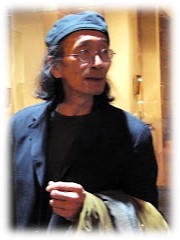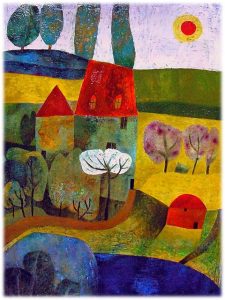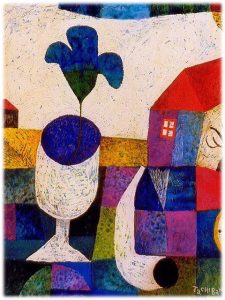


 Yoshiro Tachibana, a connection with nature, light and the woman he loved
Yoshiro Tachibana, a connection with nature, light and the woman he loved
Meeting Benches stands out from other art blogs for its unique and poetic nature, in fact, it embraces art in all its forms. Meeting Benches is a virtual meeting and inspirational place dedicated to travelers, artists, thinkers and dreamers from all over the world. Here, virtual “benches” act as a connection point, creating an atmosphere of sharing and inspiration that allows people to share art, travel stories and thoughts. You can find articles on emerging and established artists, art galleries, poems, short stories and much more. In essence, this is a digital refuge for those who love art and creativity. Among the artists featured on the platform, Yoshiro Tachibana has immortalized mystical scenarios that have been interpreted by Dastilige Nevante. Type in “Painters” if you want to know more.



 If you are interested in exploring more of the art of a Japanese artist known for his unique blend of abstract, naive and figurative painting, read on to discover a fascinating mix of influences in his paintings. Yoshiro Tachibana’s style was influenced by a form of minimalism that incorporated elements of primitive wilderness and medieval iconography. His work exudes a mysticism inspired by the natural environment and the light of his surroundings. Learn more about the mystical aspects of his work? His art is imbued with a mystical quality that draws viewers into otherworldly realms. Symbolism and nature are the two elements that contribute most to this enchantment. Bridging the earthly and spiritual realms, Tachibana utilized nature symbols such as birds, trees and celestial bodies for their profound meanings. Inviting you to explore beyond the surface, his use of color, texture and negative space helped create a sense of quiet contemplation.
If you are interested in exploring more of the art of a Japanese artist known for his unique blend of abstract, naive and figurative painting, read on to discover a fascinating mix of influences in his paintings. Yoshiro Tachibana’s style was influenced by a form of minimalism that incorporated elements of primitive wilderness and medieval iconography. His work exudes a mysticism inspired by the natural environment and the light of his surroundings. Learn more about the mystical aspects of his work? His art is imbued with a mystical quality that draws viewers into otherworldly realms. Symbolism and nature are the two elements that contribute most to this enchantment. Bridging the earthly and spiritual realms, Tachibana utilized nature symbols such as birds, trees and celestial bodies for their profound meanings. Inviting you to explore beyond the surface, his use of color, texture and negative space helped create a sense of quiet contemplation.



 Yoshiro Tachibana’s paintings often depict dreamscapes, places that exist beyond our waking reality. These dreamlike settings evoke a sense of wonder and mystery. Tachibana also drew inspiration from medieval art, including illuminated manuscripts and stained-glass windows. This influence added an ancient, timeless quality to his work. Art is subjective, so each viewer may interpret Tachibana’s mystical aspects differently. Yet, you’ll agree that his paintings invite us to explore our own inner landscapes and connect with something beyond the ordinary. When you look at “Moonlit Forest,” you may feel transported to a place where time stands still and the lines between reality and dreams blur. One of Yoshiro Tachibana’s most notable paintings, “Moonlit Forest” embodies a mystical aspect that Tachibana has masterfully combined with symbolism and ethereal light. This painting depicts a dense forest at night, with trees soaring upward. The moon hangs low in the sky, casting a soft glow on the foliage below. The forest represents both the earthly realm and a gateway to the unknown, while the trees symbolize growth, life, and connection to nature. Finally, the moon, with its mystical associations, adds an otherworldly dimension. Tachibana’s use of light is exquisite. The moonlight filters through the leaves, creating intricate shadow patterns on the ground. It is as if the forest holds secrets that are only illuminated by the moon’s gentle touch. Also noteworthy is the artist’s pioneering minimalist approach: the composition is deceptively simple, yet it captures the viewer’s attention. The lack of extraneous detail allows us to focus on the essentials: the moon, the trees, and the stillness.
Yoshiro Tachibana’s paintings often depict dreamscapes, places that exist beyond our waking reality. These dreamlike settings evoke a sense of wonder and mystery. Tachibana also drew inspiration from medieval art, including illuminated manuscripts and stained-glass windows. This influence added an ancient, timeless quality to his work. Art is subjective, so each viewer may interpret Tachibana’s mystical aspects differently. Yet, you’ll agree that his paintings invite us to explore our own inner landscapes and connect with something beyond the ordinary. When you look at “Moonlit Forest,” you may feel transported to a place where time stands still and the lines between reality and dreams blur. One of Yoshiro Tachibana’s most notable paintings, “Moonlit Forest” embodies a mystical aspect that Tachibana has masterfully combined with symbolism and ethereal light. This painting depicts a dense forest at night, with trees soaring upward. The moon hangs low in the sky, casting a soft glow on the foliage below. The forest represents both the earthly realm and a gateway to the unknown, while the trees symbolize growth, life, and connection to nature. Finally, the moon, with its mystical associations, adds an otherworldly dimension. Tachibana’s use of light is exquisite. The moonlight filters through the leaves, creating intricate shadow patterns on the ground. It is as if the forest holds secrets that are only illuminated by the moon’s gentle touch. Also noteworthy is the artist’s pioneering minimalist approach: the composition is deceptively simple, yet it captures the viewer’s attention. The lack of extraneous detail allows us to focus on the essentials: the moon, the trees, and the stillness.

 Personal experiences often find expression in an artist’s creations. The stillness of a moonlit forest at night may have resonated with his contemplative spirit. The solitude and mystery of such an environment can evoke powerful emotions. Regarding Yoshiro Tachibana‘s “Moonlit Forest,” his inspiration stems from his deep connection to nature and traditional Japanese aesthetics, his need for spiritual exploration, and even personal experiences. The appreciation of imperfection and profound beauty, celebrating simplicity, impermanence, and the invisible, is perfectly embodied in this painting. Tachibana contemplated the mystical aspects of existence, the interplay between light and darkness, the hidden realms beyond our senses. Perhaps, the artist truly encountered a moonlit forest, a place where he felt a connection to something beyond what he could merely see.
Personal experiences often find expression in an artist’s creations. The stillness of a moonlit forest at night may have resonated with his contemplative spirit. The solitude and mystery of such an environment can evoke powerful emotions. Regarding Yoshiro Tachibana‘s “Moonlit Forest,” his inspiration stems from his deep connection to nature and traditional Japanese aesthetics, his need for spiritual exploration, and even personal experiences. The appreciation of imperfection and profound beauty, celebrating simplicity, impermanence, and the invisible, is perfectly embodied in this painting. Tachibana contemplated the mystical aspects of existence, the interplay between light and darkness, the hidden realms beyond our senses. Perhaps, the artist truly encountered a moonlit forest, a place where he felt a connection to something beyond what he could merely see.

 About the Japanese artist Yoshiro Tachibana, whose life and artistic path have been as intriguing as his paintings, we want to remind you that he was born in Kobe a week after the attack on Pearl Harbor. Although he lived a childhood full of difficulties, he decided to dedicate himself to painting. He studied at the School of Fine Arts in Tokyo, where he was influenced by the works of Paul Klee. To oppose the Vietnam War through art, from 1968 to 1974, joining an anarchist group, Tachibana traveled to Russia, Hamburg and Oslo, where he encountered the work of Munch. Fascinated by the melancholic and silent atmosphere of Galicia, Spain, he settled in Muxía, where he met Paz, the woman of his life, and built their house with the help of neighbors. Their house, nestled in the O Corpiño mountain, was a refuge for living in tranquility. He shared with his wife the light that this environment loved. The quiet of that place, in fact, made him sprout a dreamlike and mythological profile similar to that of Marc Chagall.
About the Japanese artist Yoshiro Tachibana, whose life and artistic path have been as intriguing as his paintings, we want to remind you that he was born in Kobe a week after the attack on Pearl Harbor. Although he lived a childhood full of difficulties, he decided to dedicate himself to painting. He studied at the School of Fine Arts in Tokyo, where he was influenced by the works of Paul Klee. To oppose the Vietnam War through art, from 1968 to 1974, joining an anarchist group, Tachibana traveled to Russia, Hamburg and Oslo, where he encountered the work of Munch. Fascinated by the melancholic and silent atmosphere of Galicia, Spain, he settled in Muxía, where he met Paz, the woman of his life, and built their house with the help of neighbors. Their house, nestled in the O Corpiño mountain, was a refuge for living in tranquility. He shared with his wife the light that this environment loved. The quiet of that place, in fact, made him sprout a dreamlike and mythological profile similar to that of Marc Chagall.

 You can explore the life and art of Yoshiro Tachibana through “The Art of Yoshiro Tachibana,” a short YouTube documentary that provides insights into his unique style and influences, from studying art in Tokyo to settling in Galicia, Spain, where he found inspiration in the landscape and people. “Yoshiro Tachibana, Stories of Japanese Women-Goddesses with Sweet Melancholy,” on the other hand, delves into his life, challenges, and artistic evolution. Tachibana’s work is meant to be experienced visually, so look for exhibitions or online galleries to immerse yourself in his mystical, dreamlike paintings. While not exclusively about Tachibana, art books feature sections on various artists, so consider exploring books on contemporary art by Japanese artists or naive painting.
You can explore the life and art of Yoshiro Tachibana through “The Art of Yoshiro Tachibana,” a short YouTube documentary that provides insights into his unique style and influences, from studying art in Tokyo to settling in Galicia, Spain, where he found inspiration in the landscape and people. “Yoshiro Tachibana, Stories of Japanese Women-Goddesses with Sweet Melancholy,” on the other hand, delves into his life, challenges, and artistic evolution. Tachibana’s work is meant to be experienced visually, so look for exhibitions or online galleries to immerse yourself in his mystical, dreamlike paintings. While not exclusively about Tachibana, art books feature sections on various artists, so consider exploring books on contemporary art by Japanese artists or naive painting.








